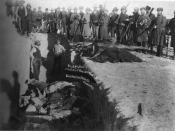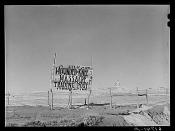The battle of Wounded Knee was a tragic event in United States history marking this as a period in time when Native American people were not accepted as Americans and were outlawed the rights established to the white population. The Lakota Sioux Nation and its people were not allowed a place in white society. Their land, which acknowledged as there's by the treaty of Laramie was broken and taken from them, lives were taken, and rights were denied. Wounded Knee was a crucial event in the growing hostility between the Sioux Indians and the United States government. The repercussions of Wounded Knee are motionless and are reflected in the twenty-first century. This has brought long term and short term social, cultural effects on the Lakota Sioux Nation. The Dawes Act and the 1952 Termination Policy could in no circumstances even be related or compared to the horrendous and catastrophic levels as the battle of Wounded Knee.
In the spring of 1973, the battle of Wounded Knee took place with hundreds of the Lakota Sioux Nation and their supporters occupied the village of Wounded Knee on the Pine Ridge Indian Reservation in South Dakota. They demanded an end to the persecutions that the U.S. government bestowed on them, by result in murder, intimidation of American Indian Movement (AIM) supporters on the reservation. The Lakota Nation demanded that treaties signed by the U.S. government be honored that gave the Lakota Sioux Nation the right to self-rule and to the territory surrounding the Black Hills. Federal authorities surrounded the Lakota Sioux Nation with an army of over 300, which included the U.S. Army, FBI and Bureau of Indian Affairs (BIA) agents, U.S. Marshals and state police. The Indians refused to back down. They used weaponry to defend themselves and held off the...


